Features of growing gymnospermous pumpkin and what seeds you should pay attention to
Many have heard about the benefits of pumpkin seed oil. Regular use of the product removes cholesterol from the body and improves well-being. Pumpkin seed oil is much healthier than sunflower and even olive oil. It is made from pumpkin seeds.
In production, gymnosperms are in special demand varieties, which contain the maximum amount of seeds. You can grow such a pumpkin in a regular garden area. How to plant and grow a vegetable correctly, we will consider further.
The content of the article
Brief descriptions of the most popular varieties
Golosperm varieties have been grown in Russia since 1911. Pumpkin seeds even used in confectionery. Most gymnosperms give their first harvest in 3-4 months. The return from gymnosperms is excellent.
Vegetables delight not only with their taste, but also with their bright appearance. Consider the characteristics and descriptions of the most popular varieties of gymnosperm pumpkin.
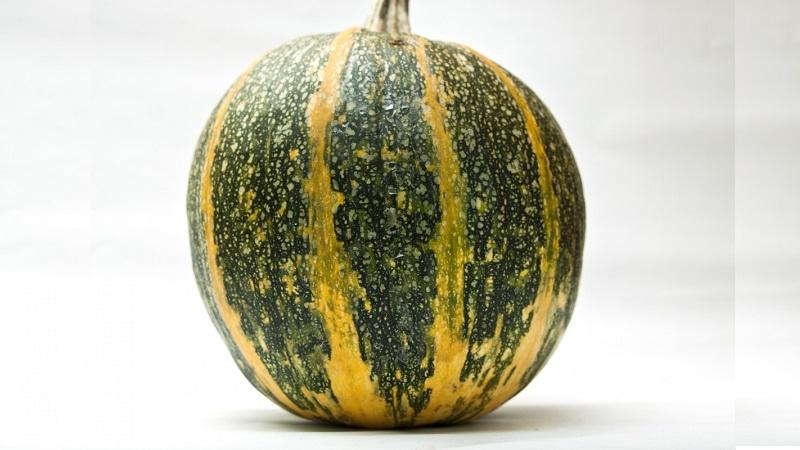
Olga
A mid-season variety with a particularly high seed content. The pumpkins are large, one weighs about 5 kg. It has an unusual green-orange color and medium-sized lashes. The pulp is of medium thickness, the taste is fresh-sweet, poorly expressed. Seeds without peel, green.
Pumpkin Olga is planted mainly in the open field, even in central Russia. Not afraid of frost and short summer, resistant to rain and fog. Due to the large size of vegetables, it needs additional support.
Interesting.What are the benefits and harms of gymnosperms pumpkin? The oil has a beneficial effect on the skin and hair. The product is actively used in the manufacture of cosmetics.
The vegetable is contraindicated for people with severe diabetes mellitus and sensitive digestion.
Apricot
The variety appeared thanks to the work of the Ural breeders, therefore it takes root well in the Urals and Siberia. Gardeners only respond positively to the variety, appreciate it for its sweet pulp and easy care. Slightly ribbed pumpkins ripen in 3.5 months.
The main characteristics of the fruit are as follows:
- The surface is yellow with large green stripes.
- The pulp is slightly fibrous, light yellow in color.
- Seeds without shell, oil.
- It is used both fresh and after heat treatment.
How to use Apricot seeds? They are added to vegetable side dishes and salads, and are also used as a decoration for dishes. Thanks to the seeds, food becomes not only tasty, but also healthy.
Danae
 Danae has a pleasant orange pulp and delicate taste. It is grown in greenhouse conditions or greenhouses, but some gardeners plant it under the open sky. It is recommended to plant Danae seedlings - so it will be easier for the plant to get used to the climatic conditions.
Danae has a pleasant orange pulp and delicate taste. It is grown in greenhouse conditions or greenhouses, but some gardeners plant it under the open sky. It is recommended to plant Danae seedlings - so it will be easier for the plant to get used to the climatic conditions.
Danae is unpretentious in leaving. Watering, feeding and timely formation of lashes are required. The weight of a mature vegetable varies from 5 to 20 kg. The surface is uneven and rough.
Tear off the variety carefully, along with the stalk, which allows the pumpkin to maintain its freshness and vitamin composition longer. After harvesting, it is not recommended to wash the pumpkin with water, it is better to just wipe it with a dry cloth.
Store Danae pumpkin in the refrigerator, on the balcony or in a dry, ventilated basement. The variety has good keeping quality, so you can feast on pumpkins even in winter.
Gymnosperm 14
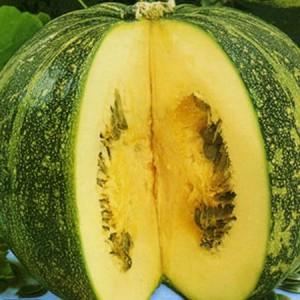 The peculiarity of the variety is that it is difficult to purchase it in stores or over the Internet. Basically, Golosemyannaya 14 is obtained through familiar gardeners or neighbors.
The peculiarity of the variety is that it is difficult to purchase it in stores or over the Internet. Basically, Golosemyannaya 14 is obtained through familiar gardeners or neighbors.
Especially valuable variety, is a large green vegetable with lots of healthy seeds that are rich in fiber. Bushes and roots are powerful, medium length lashes. The yield is excellent.
Sunflower seeds have a positive effect on the functioning of the entire cardiovascular system. Amino acids have a beneficial effect on blood vessels, improve their permeability and elasticity.
Potassium is good for the heart muscle. It is noteworthy that regular consumption of pumpkin seeds normalizes blood pressure.
Features of growing gymnosperms
For the first time, the benefits of gymnosperms were discussed in Austria. It was there that farmers and agronomists began to extract pumpkin seed oil... Today these varieties are grown all over the world. We will learn the secrets of getting a rich harvest.
Growing seedlings
Seedlings are necessary for the plant to adapt and develop faster on the land. Seedlings are prepared 2-3 weeks before planting in the ground. For this, high-quality seed is selected and disinfected. Aloe juice is recognized as an excellent disinfectant.
Just soak the seeds in it for 24 hours, then dry well. Aloe juice removes the surface of the material from dangerous microbes and thereby protects the plant from possible diseases.
After disinfection, the germination stage begins. The procedure shows the overall germination of the seeds and helps the sprouts to emerge faster. It is advised to germinate the material in a warm and dry place. For the most accelerated development, the seeds are soaked not in warm water, but in the Kornevin preparation. The tool strengthens the immune system and protects against diseases.
Important! Prepare the container and soil for seedlings. Wooden boxes or plastic containers with a pallet are ideal containers. They are affordable and easy to use. It is better to buy soil for seedlings in the store. The finished formulations are already pre-disinfected and saturated with the necessary vitamins.
Store seedlings in a dry and warm place. The pumpkin loves sunlight and regular watering. The water temperature must be at least 18 degrees. Do not use cold tap water - this is dangerous for young sprouts.
After 5-7 days, it is advised to organize the first organic feeding. For example, a solution of liquid bird droppings. A week before disembarkation, lower the air temperature by 2-3 degrees daily. This will harden the seedlings and improve their development in the future.
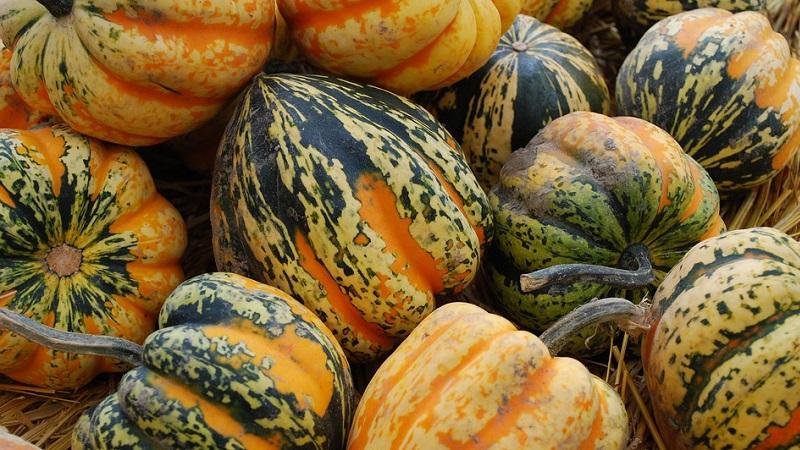
Garden care
Planting gymnosperms is recommended after corn, legumes or potatoes. Choose a well-lit and sun-warmed area. The place should be calm and with fertile soil.
Watering
The amount of watering depends on the variety and climatic conditions of the growing region. On average, water the vegetable every 5-7 days. 1 bush takes about 2 liters of water. If possible, use mainly melt or rainwater. During flowering and fruiting, the amount of moisture is increased by 1.5 times. Watering is stopped 2 weeks before harvesting.
Important! Often, the culture is watered not with water, but with an ash solution. Ash is an indispensable tool in the garden; it reduces the acidity of the soil and makes it more nutritious for the future harvest. Watering with a solution is carried out once a week.
Loosening the beds
The loosening depth is about 7-10 cm. The procedure provides oxygen access to the roots, and also reduces moisture evaporation. In addition, loosening is useful for killing weeds and the larvae of harmful insects. It is best to loosen the beds after rain and before watering.
Lash formation
When the lashes grow more than 2.5 m, they must be formed. To do this, leave 2 pumpkins on one, and remove the rest of the lash. If this is not done, there will not be enough nutrients for all vegetables, and the amount of the harvest will significantly decrease.
Also, gardeners are advised to leave only 3-4 leaves on one lash. Otherwise, excessive amounts of them will make it difficult for pumpkins to get sunlight.
Top dressing
The best effect is provided by mineral and organic fertilizers. The first feeding is done after 2 weeks. Excellent remedies are urea and ammonium nitrate. They are rich in nitrogen and phosphorus, which are essential for the normal development of the plant.
Also, pumpkin responds well to Nutrivant Plus Pumpkin. A product with an environmentally friendly composition is effective in use and significantly improves the quality of vegetables.
Important! To obtain the most delicious and beautiful vegetables, feeding is carried out throughout the entire ripening period. The interval between procedures is 2 weeks. From mid-August, they stop fertilizing the pumpkin, since the ripening stage begins. An excess of fertilizers during this period degrades the quality of gymnosperms and makes the pulp tough.
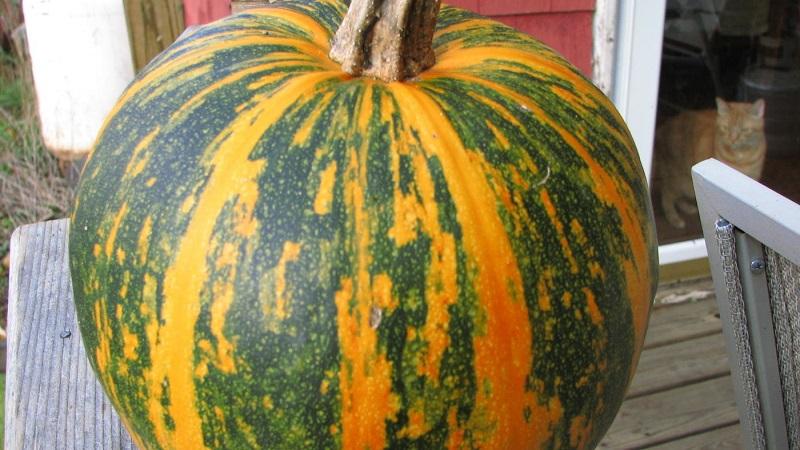
Prevention of diseases and pests
Even if all agrotechnical rules are followed, the culture can get sick with a fungus or a virus. The most common plant is bacteriosis or powdery mildew. To prevent their occurrence, pay special attention to spraying bushes.
Soap solution is recognized as an excellent remedy for diseases. 5 liters of water will require 100 g of dry grated soap. The beds are sprayed with a spray bottle, once every 5-10 days. It is best to do this in the early morning so that a protective soap film has time to form on the bushes before the sun appears.
Also, there is a dangerous disease white rot. The infection affects the pumpkins themselves: at first they are covered with a white bloom, and then they rot. To prevent it, it is recommended to water the fruits only with warm water and feed them with ammonium nitrate and copper sulfate. On dry and hot days, it is advised to remove the affected leaves and sprinkle the bushes with crushed coal.
Of the pests on pumpkin beds, spider mites are found, which envelop the leaves with a thin cobweb. Because of her, the leaves dry out and slowly wither. In hot weather, the culture is sprayed with an infusion of onion peels or a celtan solution. After harvesting, we advise you to dig up the soil well in order to prevent the mite from appearing again.
Important! As a preventive measure, it is advised to observe the hygiene of the beds, regularly fertilize the bushes and spray with Bordeaux liquid or a solution of copper sulfate. It is also important to treat the seeds and soil well before sowing to prevent diseases or unwanted insects.
Reviews of gardeners
The naked gourd is controversial. Some gardeners do not like it because they believe that the main thing in the pumpkin is the pulp, not the seeds. However, many farmers are willing to argue with them.
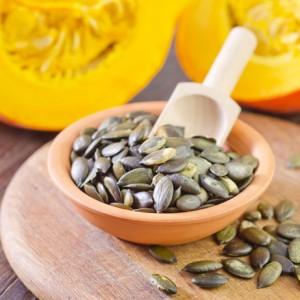 Alexander, Rostov-on-Don: “I love trying unusual vegetables on my site. I decided to plant the variety Golosemyannaya 14 and was not disappointed. Although the vegetable does not look like a pumpkin in the conventional sense, I was pleased with the harvest. I put some of them into blanks, and some I ate fresh. The green seeds also tasted great. I baked bread and cupcakes with them for tea. "
Alexander, Rostov-on-Don: “I love trying unusual vegetables on my site. I decided to plant the variety Golosemyannaya 14 and was not disappointed. Although the vegetable does not look like a pumpkin in the conventional sense, I was pleased with the harvest. I put some of them into blanks, and some I ate fresh. The green seeds also tasted great. I baked bread and cupcakes with them for tea. "
Maria, Ufa: “My favorites are nutmeg and gymnosperms. I especially love pumpkins Olga. They don't come out that big, so they're easy to use in the kitchen. And in my opinion, this variety requires a minimum of attention. "
Valeria, Orsk: “I planted the Danae variety once. The manufacturer promised dense pulp and a large number of seeds. The result is fibrous, semi-empty vegetables. I think this is a manufacturing defect, but there is no desire to try Danae anymore. "
Conclusion
Gymnosperm pumpkin varieties are indispensable for those who monitor their diet and eat only healthy and wholesome food.
The product has large, uncoated seeds so there is no need to peel them. Moreover, these vegetables are easy to grow, and many of them show excellent results even in the north of the country. The main thing is to follow the simple rules of planting and leaving.